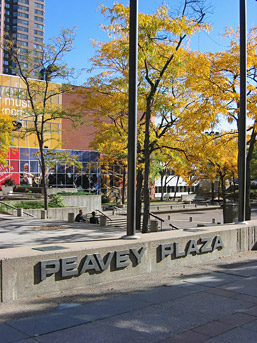
Nicollet Mall
Minneapolis, Minnesota
Peavey PlazaMinneapolis, Minnesota

History
Peavey Plaza was a product of the upheaval in urban America after World War II, when many cities were in crisis.
Businesses and residents that were able to move to the suburbs did. Those left behind saw their communities drained of economic vitality, bisected by freeways, torn by social strife. Minneapolis began witnessing the same pattern when General Mills announced plans to move its downtown headquarters to a suburban campus. Instead of joining the exodus, however, a group of powerful business leaders and far-sighted government officials led a counterattack, funneling investment back into the city. The mid-century renaissance, symbolized by the innovative Guthrie Theatre, the new Walker Art Center building, and the ever-optimistic Mary Tyler Moore, made Minneapolis into a Mecca for urban planners. Many made pilgrimages to the Nicollet Mall, downtown’s major retail street. An eight-block segment between Washington Avenue and Tenth Street was transformed in the 1960s by a plan produced by Lawrence Halprin and Associates. Car traffic was removed and buses were routed along the sinuous path through the landscape design meant to seduce pedestrians. Nicollet Mall garnered international acclaim and was much copied—but rarely with equal success.
The mall was, in fact, almost too successful. Organized festivities drew crowds as hoped, but the clogged sidewalks made it hard for shoppers to get to stores. Plans were soon underway to extend the mall four blocks south, adding a plaza along the way as a gathering place for programmed events and an informal refuge from the dense city grid.